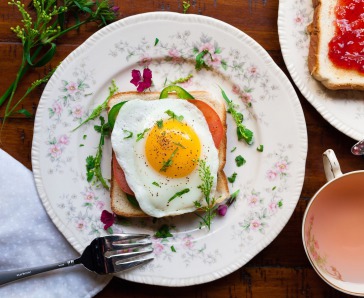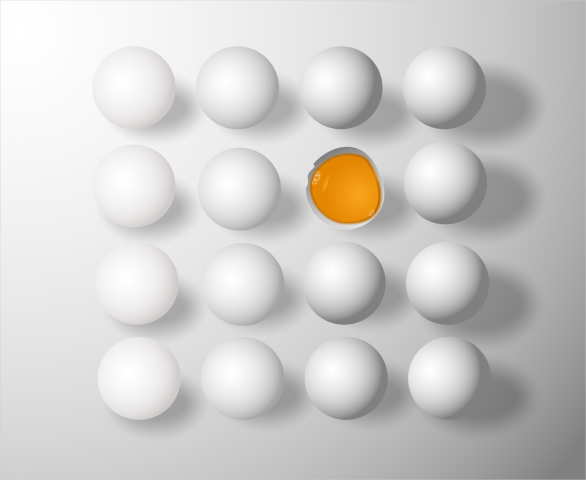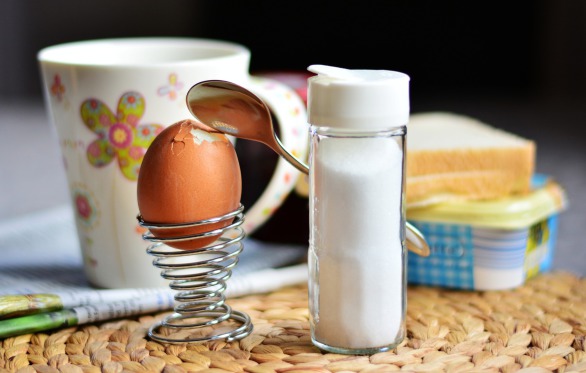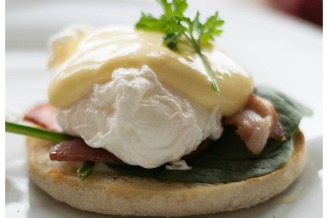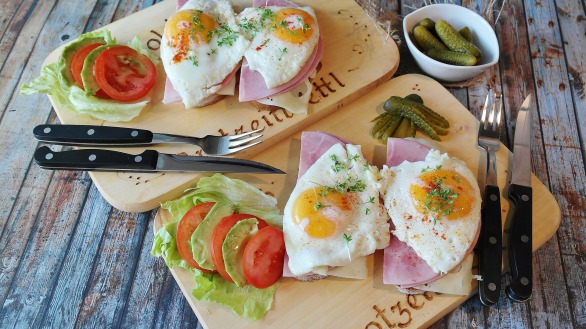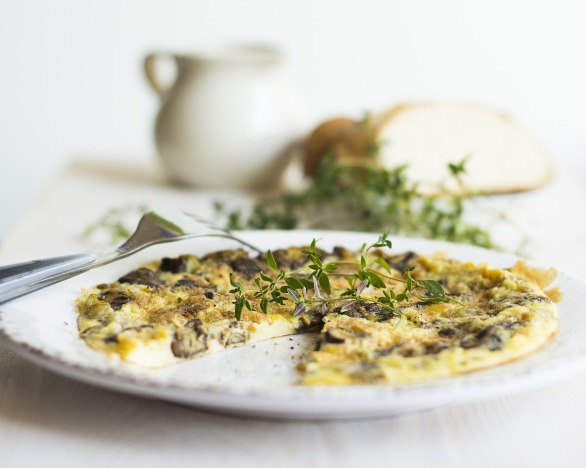
This article has been adapted by AJNS New Media for publication on www.kitchenstories.com. Click on this link to find that version, which can be read in English, German or Chinese. You'll also discover many more wonderful stories and a beautiful collection of recipes, photos and videos that have been lovingly prepared and provided by the Kitchen Stories team. Alternatively, check out my article below to enjoy the text in its original form. Either way, happy reading!
Eggs, Eggs, Eggs for Your Delectation
Eggs are incredibly versatile and can be prepared in numerous ways. They are delicious enough to be the star of a dish, and they’re also useful when recipes call for ingredients to bind and gel other ingredients together — think muffins, quiches and meatloaf, just to name a few. But let’s begin our journey of egg discovery by considering a popular egg-related question.
What came first, the chicken or the egg?
Science and the principles of evolutionary biology have finally offered some answers to this. According to the Australian Academy of Science, “The very first chicken in existence would have been the result of a genetic mutation (or mutations) taking place in a zygote produced by two almost-chickens (or proto-chickens). This means two proto-chickens mated, combining their DNA together to form the very first cell of the very first chicken. Somewhere along the line, genetic mutations occurred in that very first cell, and those mutations copied themselves into every other body cell as the chicken embryo grew. The result? The first true chicken.”
Based on this, it seems to me that the very first chicken egg was the very first egg that hatched a chicken. That chicken then went on to reproduce, and that’s how chickens and their eggs came into existence. So, in answer to this eggcellent question, which is still hotly debated in some circles, I put my money on the egg coming first.
How to tell whether an egg is still fresh
Check the date. If the eggs are within their expiration or sell-by date (printed on the pack), they may not be super fresh but they should still be safe to eat. If they're past those dates, they may still be fresh enough to eat, especially if they’ve been refrigerated. However, it’s also possible that they’re not. Keep reading to find out how you can check eggs for freshness at home.
Do the sniff test. If you’ve bought some eggs and they’ve been sitting in the fridge for a while, this method is simple but effective. Give the whole egg (in its shell) a sniff, and if it’s odourless, it should be fine to eat. If it smells off, it’s best to throw it away. If you’re in doubt, crack the egg open and sniff the contents.
Check the shell. Cracked, slimy or powdery shells indicate that the egg is not safe to eat. If the shell is cracked or slimy, it’s most likely that bacteria is present. If the shell is powdery, it’s a sign of mould.
Check the colour of the contents. Crack the egg onto a clean white plate and check for any pink, green, blue or black discolouration. If you find some, it means that the shell was damaged or the egg is old. Also, it likely means that there’s harmful bacteria growth. If there’s any chance that might be the case, discarding the egg is the best way forward.
Do the float test. Fill a bowl with cold water and gently lower the eggs into the water. If the egg sinks to the bottom and lays on its side, it’s fresh. If it stands on one of its ends at the bottom of the bowl, it’s likely a few weeks old, but it should still be good enough to eat when fully cooked. If the egg floats to the surface, it’s time for the egg to go in the bin because it’s too old.
This method is great for showing you how fresh an egg is, but it’s important to note that it does not show you whether an egg is still good or has gone bad. That’s why it’s a good idea to use it in combination with at least one of the other methods outlined above.
What are pasteurised eggs?
Businesses who deal in the production of food wish to avoid their products making customers sick with food-borne illnesses, so they use a process called pasteurisation. It involves briefly exposing foods and drinks to heat (approx. 60°C/140°F) in order to kill any harmful bacteria. Pasteurised eggs have undergone this process.
What do all of the labels really mean?
- Natural Eggs
We might like to picture happy chickens when we hear the word ‘natural’. Unfortunately, this label means quite the opposite in this case. ‘Natural’ or ‘All natural’ often refers to eggs from battery chickens.
- Free-Range Eggs
Free-range eggs are from chickens that are given access to an outdoor space. However, that outdoor space may not necessarily be pleasant for them, depending on the provisions made by the producer.
- Cage-Free Eggs
The term ‘cage free’ tells us that the chickens aren’t raised in cages, which means that they do have a little space to stretch their legs and wings, but it tells us nothing of their actual living conditions.
- Organic Eggs
Organic eggs come from chickens that have been fed only with organic feed and not treated with hormones. Many producers also adopt a free-range approach to raising organic chickens, but not all.
- Omega-3 Eggs
These eggs come from chickens fed on food enriched with omega 3, often through the addition of flaxseed. This is meant to enrich the eggs.
- Humane Eggs
Humane eggs come from chickens that have been raised and treated humanely by their owners, who have been awarded Humane Certification. They may or may not be fed with certified organic feed.
- Pasture-raised Eggs
Pasture-raised eggs come from chickens kept mostly outdoors. They have space to roam as well as shelter when needed. They are generally (location dependent) able to have a diet of insects, worms and grass they find themselves, in combination with some kind of feed provided by the producer, which may or may not be organic.
The basics of cooking eggs
Boiled eggs
Whether you prefer them hard or soft, boiled eggs are undeniably yummy. When you need an egg that holds its shape in a salad or a sandwich, a medium- or hard-boiled egg is the way to go. But if you need something to dip your soldiers into, only a soft, luscious, liquid-gold centre will do.
Peeling boiled eggs needn’t be stressful, either. Raw eggs lowered into boiling water or hot steam will often peel easier than eggs started in cold water. Also, peeling boiled eggs under cold running water helps, but don’t forget to put something in place to catch the shell. Additionally, eggs that are a little less fresh tend to peel more easily, so use the freshest eggs for mayonnaise and poached or fried eggs.
Here’s how I approach the boiling of a medium-sized egg. To boil one egg and achieve a soft and runny set, lower the egg into boiling water and boil for 4-5 minutes. For a medium set on the yolk, do the same but boil for 6-7 minutes. For a hard set, boil for 8-9 minutes. The blue ring that sometimes forms around a hard-boiled yolk is a sign that the egg is overcooked. That’s why it’s important to stop the cooking process in its tracks by running cold water over your cooked egg straight away.
There are a couple of things you can do to stop eggs from cracking in the water. If they’re going to be lowered into boiling water, bringing them to room temperature 30 minutes before cooking can make a difference. Also, piercing the eggs on one end before cooking will help, either with an egg piercer, a needle or a pin.
Onto a slightly crazy-sounding idea: microwaveable boiled eggs. Simply heat up a bowl of water (deep enough to submerge your egg in) for three minutes until hot. Pierce the egg, place it in the hot water, cover with a plate and microwave at 50% power for 4 minutes. Be sure to follow these instructions exactly, otherwise, you might have an eggsplosive situation on your hands. If you’re aiming for a runny yolk, carefully remove the egg after 4 minutes, rinse and peel. If you’re aiming for a firmer set, restart the microwave and cook for a further 2 minutes.
Poached eggs
Poached eggs can be a dream to eat but a nightmare to make. The first tip to make it easier is to use fresh, cold eggs, as the white will be easier to handle. Also, bring the water to a boil but then reduce to a simmer before swirling it and adding the egg(s), and crack the egg into a ramekin first to make it easier to control sliding it into the water.
Adding a splash of vinegar to the water encourages the white to set rather than disperse into annoying ribbons, and some people like to add salt to the water for flavour. Although, others feel that it causes the white to become more fragile. There’s no right or wrong about this; it’s just a matter of preference and experience. When cooked, remove the poached egg with a slotted spoon and allow the excess water to drain on a kitchen towel before serving.
Fried eggs
Cooking fried eggs is simple if you follow some basic rules. Fresh eggs work best as the whites will hold together and create a nice set around the yolk. Also, heat the pan to medium-high, but once the egg is cracked into the pan, immediately reduce the heat to medium-low. This will stop the white from becoming tough and rubbery and allow time for the egg to cook evenly. When ready, remove the egg with a spatula or gently slide it out of the pan and drain off any excess fat on a kitchen towel. Season and serve immediately.
Scrambled eggs
Some like to add water to their scramble, some like to add milk, some (like me) prefer to add cream, and some take the purist approach and add nothing. Water tends to give scramble a light and fluffy texture, milk gives a soft but firmer consistency, while cream tends to create a more luscious mouthfeel. And let’s not forget that the amount of butter you add also makes a difference. I like my scramble to be rich and creamy. That’s also the reason that I remove the pan from the heat a minute or two before the eggs are fully cooked and allow them to bask in the residual heat of the pan to finish cooking.
Cook scramble on a medium-low heat to avoid it drying out, and if you like your eggs to be extra tender, beat and salt them 15 minutes before cooking. The salt affects the proteins in the eggs, so it's a great tip to keep in mind if you're a lover of extra-tender scramble.
Omelettes
A classic French omelette is usually made with the addition of water or milk to the eggs. It has a fine and delicate exterior and a moist, tender interior, and it must be cooked quickly on a medium-high heat. It should be shaken in the pan while it's being cooked, and the egg mixture should be gently stirred throughout the process until the eggs just begin to set. Yes, this is a two-handed job: one to shake and the other to stir. When cooked, the omelette can be rolled to create its characteristic shape, or it can be folded in half. Light fillings can be added before rolling and folding.
On the other hand, diner-style omelettes generally include milk and are cooked more slowly on a medium-low heat. The set edges of the omelette are gently teased up, allowing the remaining egg mixture to run underneath and cook, creating a thicker, denser result than that of a French omelette. The lower heat also stops it from browning too quickly before the eggs are evenly cooked. A diner omelette is usually served folded in half.
Frittatas
A frittata is an Italian-style omelette, which is served open faced and usually browned under a grill after being fried. It often contains vegetables, meats and cheeses that are mixed into the egg mixture and cooked together in a frying pan, rather than the fillings being added at the end.
Baked eggs
Baked eggs, also known as shirred eggs or eggs en cocotte, can be a simple combination of an egg and some seasoning, or they can include a splash of cream — for flavour and to protect the yolk from drying out — and a range of other delicious ingredients in the bottom of the dish to jazz it up. They are often baked in small, flat-bottomed oven dishes or ramekins and they’re relatively quick to prepare and bake.
